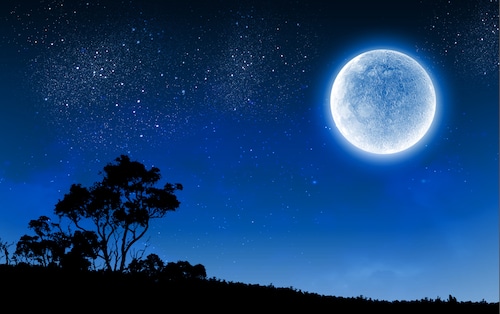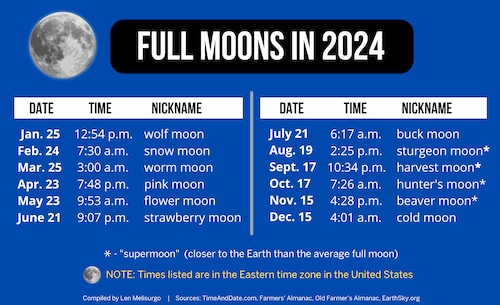
2024-08-18 15:45:02
Stargazers will be getting a few interesting treats in the next few months, starting with the full August “sturgeon moon,” which will be the first of four consecutive supermoons as well as doubling as a seasonal blue moon.
The moon, which officially turns full during the afternoon on Monday, Aug. 19, will not look blue. But it is classified as one of two different types of blue moons because it occurs fairly infrequently. It is considered a “seasonal blue moon” because it’s the third of four full moons occurring during the same season.
Summer started on June 20 this year and ends on Sept. 22, with four full moons instead of the typical three occurring during that three-month period. (June 21, July 21, Aug. 19 and Sept. 17)
Another type of blue moon — a monthly blue moon — is the second of two full moons occurring during the same calendar month, but that won’t be the case with the August moon.
Experts from NASA say monthly blue moons occur about once every two to three years. That’s because the lunar cycle takes 29.5 days to complete, from a new moon to a full moon, and most months have 30 or 31 days.
As a result, an occasional month will start with a full moon and end with another one.
Similar to monthly blue moons, seasonal blue moons occur about once every two to three years. So they are infrequent, but not extremely rare.

The full moon in August 2024 will be the first of four consecutive supermoons, and also a certain type of “blue moon.”Photo Illustration| Canva
When to see the August full moon
The upcoming blue moon will officially turn full at 2:25 p.m. Eastern time on Monday, Aug. 19. It will appear 98% illuminated Sunday night, 100% illuminated Monday night and 99% illuminated Tuesday night, according to MoonGiant.com.
On Sunday, the near-full moon will start rising in the east-southeastern sky at about 7:36 p.m. in the New York City region and in the Newark area of northern New Jersey, according to TimeAndDate.com. The moonrise time will be around 7:38 p.m. Sunday in the Philadelphia region.
On Monday, the full supermoon will begin to rise in the east-southeastern sky about 8:07 p.m. in the New York City and Newark region. The moonrise time will be around 8:10 p.m. Monday in the Philadelphia region.
On Tuesday, the moon will start rising in the eastern sky at 8:34 p.m. in the New York City and Newark area and 8:38 p.m. in the Philadelphia area.

These are the dates, times and nicknames of the 12 full moons that will be shining in the sky in 2024. The times are listed in the Eastern time zone.Len Melisurgo | NJ Advance Media for NJ.com
What is a supermoon?
Supermoons are moons that become full when their orbits are closer than average to the Earth — making them appear to be slightly bigger and as much as 30% brighter than ordinary full moons, especially when they begin to rise.
Although the precise definition varies in the astronomy world — and some experts say the average stargazer won’t notice the size and brightness difference — many say a supermoon is a moon that tracks less than 223,000 miles from the Earth during its full phase. (Some say any full moon that is 226,000 miles or closer to the Earth can be classified as a supermoon, and others set the cutoff at the precise distance of 223,694 miles.)
And some, like prominent astronomer Fred Espenak, use a special formula to calculate the “relative distance” of the moon when it reaches its closest point of orbit.
Sturgeon moon nickname
The most common nickname of the August full moon is the “sturgeon moon,” but some people call it the “green corn moon” and the “grain moon,” according to the Farmers’ Almanac and the Old Farmer’s Almanac.
North America’s largest fish is the sturgeon, and they used to be plentiful in rivers and lakes this time of year, which is why some Native American tribes gave the full August moon the nickname “sturgeon moon.”
The name seemed to stick during Colonial times, according to timeanddate.com. Sturgeons can grow as big as 6 feet long and weigh as much as 200 pounds.
Some Native American tribes referred to the August full moon as the green corn moon, a reference to the start of the corn harvesting season in some parts of the United States.
Thank you for relying on us to provide the local news you can trust. Please consider supporting NJ.com with a voluntary subscription.
Len Melisurgo may be reached at LM********@************ia.com or on X at @LensReality.




